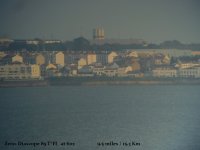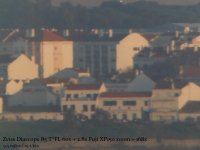It's been years since I took the spotter out. I've been more into binoculars.
Recently, however, I am looking into greater distances and birds.
I took the 20x/40x 60mm Swift spotter out to a hill nearby where you
can see field edges, ponds, woods, and development, and Boston 22 miles
away. The weather was a little windy, 50 degrees F but raising under a
strong sun.
I expected Boston to be a blur, given a little haze and a lot of distance.
When I looked at a development 2 miles away, however, there was a lot
of shimmer and blur. Going from 20x to 40x just increased the appearance
of the wiggling. Fixing on a large pond with a few houses 1/2 mile away,
I got a better view, but the mullions on the windows, for example, were
doing quite a "snake dance". When a gust blew through a thick pine
grove halfway along the sight line, the distortion got pretty bad for
a minute. Maybe this was a blob of heat from the sun-warmed trees...
...not sure. It might have been the wind. I could have recognized a
familiar face on the lawn at 20x or 40x, I think, at good moments,
but I don't think even the 40x could yield more detail at the distance.
Was I seeing something rare or common?
I have a friend looking to follow wind surfers at 1/2 to 1 mile out.
If terrestrial shimmer is worse than astronomical, is looking out
over the ocean even worse? Wind surfing happens in windy places, after all.
I'm thinking....40x can get me more detail at 100 to 300 yards,
but the atmosphere scuttles power past 20x at longer ranges. Are there
rules or thumb on this? I'm a bit surprised....maybe it was a 'bad' day.
Recently, however, I am looking into greater distances and birds.
I took the 20x/40x 60mm Swift spotter out to a hill nearby where you
can see field edges, ponds, woods, and development, and Boston 22 miles
away. The weather was a little windy, 50 degrees F but raising under a
strong sun.
I expected Boston to be a blur, given a little haze and a lot of distance.
When I looked at a development 2 miles away, however, there was a lot
of shimmer and blur. Going from 20x to 40x just increased the appearance
of the wiggling. Fixing on a large pond with a few houses 1/2 mile away,
I got a better view, but the mullions on the windows, for example, were
doing quite a "snake dance". When a gust blew through a thick pine
grove halfway along the sight line, the distortion got pretty bad for
a minute. Maybe this was a blob of heat from the sun-warmed trees...
...not sure. It might have been the wind. I could have recognized a
familiar face on the lawn at 20x or 40x, I think, at good moments,
but I don't think even the 40x could yield more detail at the distance.
Was I seeing something rare or common?
I have a friend looking to follow wind surfers at 1/2 to 1 mile out.
If terrestrial shimmer is worse than astronomical, is looking out
over the ocean even worse? Wind surfing happens in windy places, after all.
I'm thinking....40x can get me more detail at 100 to 300 yards,
but the atmosphere scuttles power past 20x at longer ranges. Are there
rules or thumb on this? I'm a bit surprised....maybe it was a 'bad' day.






